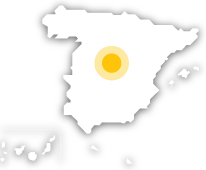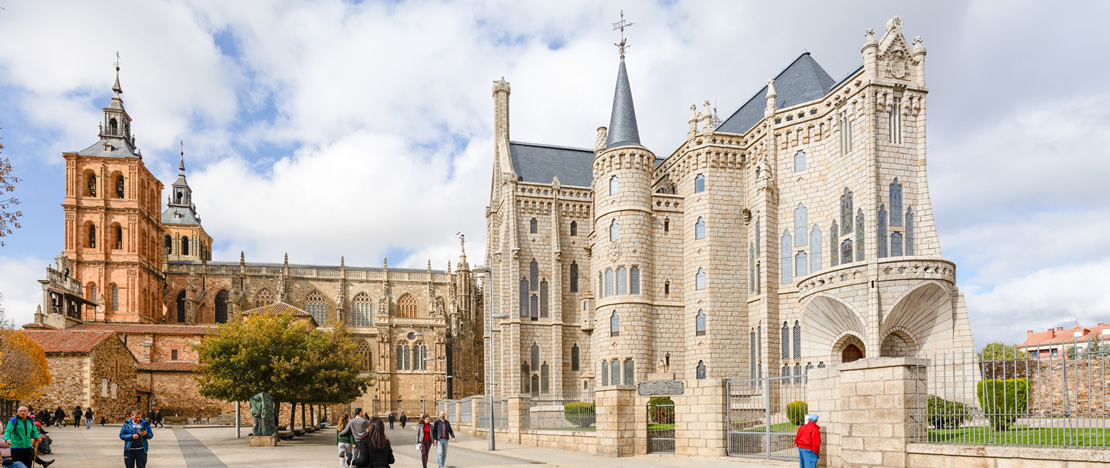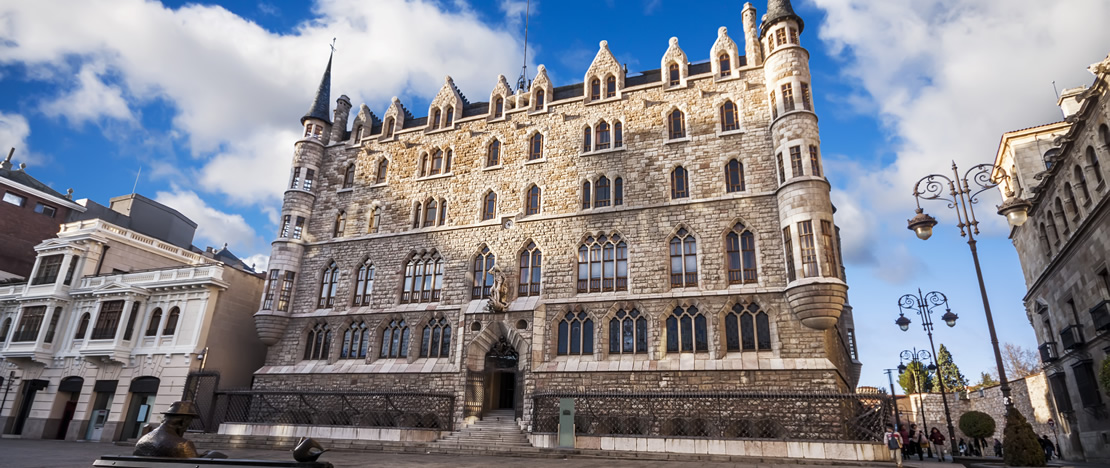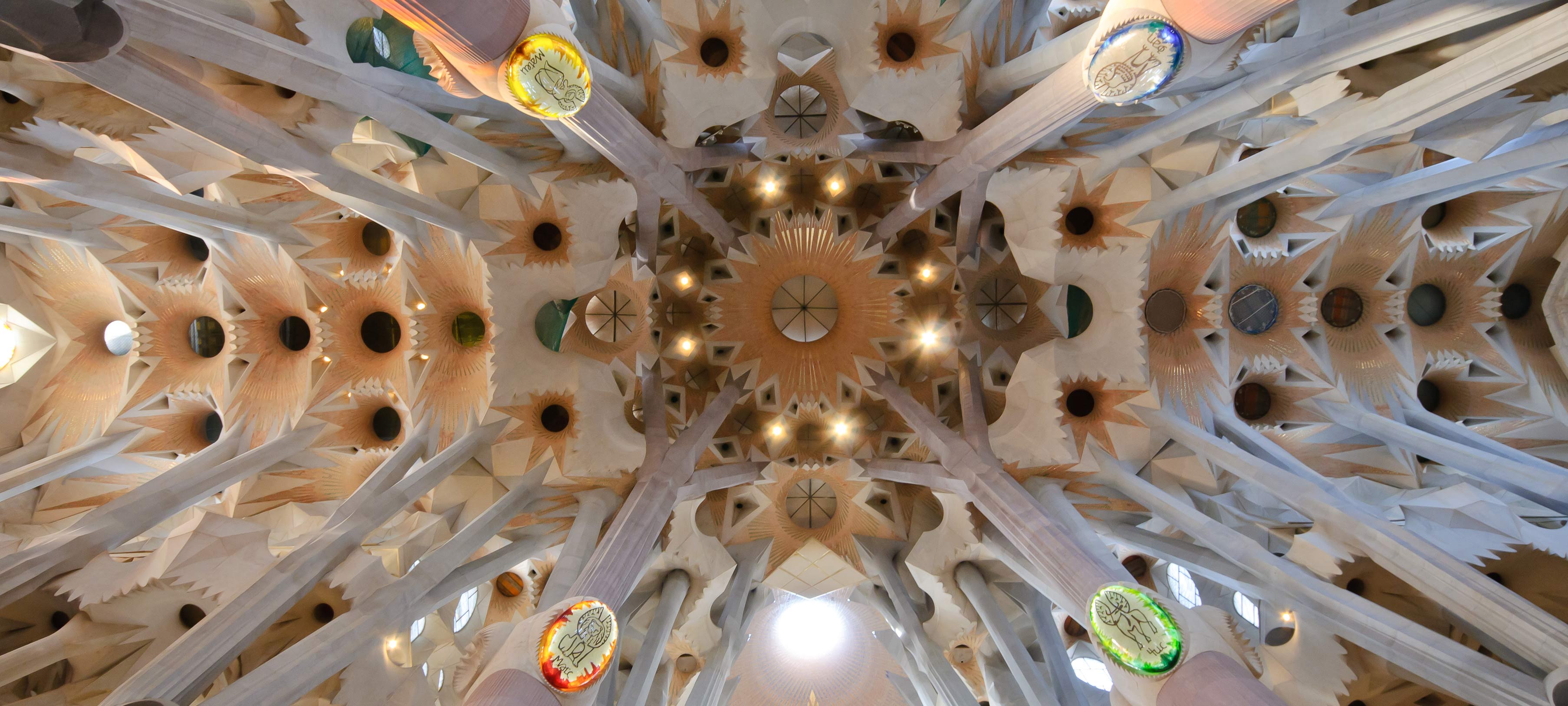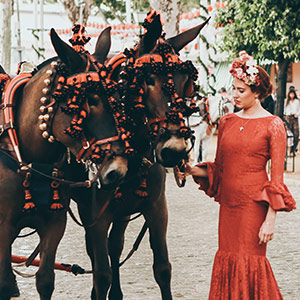
The Gaudí Way in northern Spain
Did you know that the Episcopal Palace in Astorga, the Casa Botines Museum in León and Gaudí's El Capricho in Comillas are the only three buildings by the famous modernist architect outside Catalonia? These works by Antonio Gaudí trace a very special itinerary between Cantabria and Castilla y León to discover his legacy in the north of Spain. The Gaudí Way invites you to make a pilgrimage through these charming destinations and discover their cultural richness.
Debe activar Javascript para poder utilizar este servicio
-
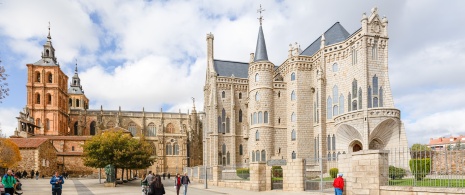
Gaudí Palace, a tribute to the Middle Ages
The medieval splendour of the city of Astorga, in the province of León, and the incomparable creativity of Antonio Gaudí are embodied in the majestic Palacio Episcopal, dating from 1889. Built with granite from El Bierzo, this neogothic building combines the features of a castle, a temple and a stately palace. The moat that surrounds its entire perimeter is Gaudí's homage to feudal castles. Spaces such as the chapel, the throne room and the dining room contain modernist decorative elements in the form of star-shaped capitals and historiated stained glass windows. To this must be added the beauty of its garden, presided over by the figures of three angels.Right next to the palace is the imposing Catedral de Santa María, a magnificent example of Gothic architecture. Wander through the charming cobbled streets of the city and admire the remains of the ancient Roman walls, dating back to the 3rd century AD. If you visit the Roman Museum you will understand the importance of this city in the Roman Empire. In addition, every July the Astorga Roman Games are held, a spectacular historical re-enactment.After admiring the Plaza Mayor square and its emblematic town hall building, with its elegant neoclassical façade and clock tower, you can choose one of the many bars and restaurants in the area to enjoy the local gastronomy. The cocido maragato or the mantecadas and puff pastries are some essential references. The city's star product deserves a special mention: chocolate.Astorga is a benchmark in the manufacture of this sweet and proof of this is its Chocolate Museum. An interactive experience awaits you there with exhibits that recreate the production process, from the cocoa harvest to old tools and machinery, as well as the different varieties of cocoa that exist. The visit ends with a tasting of chocolates of various flavours made in the region.
-
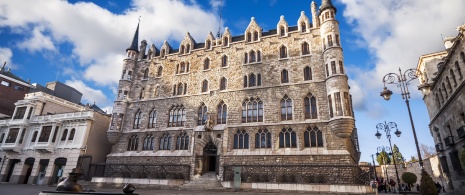
Casa Botines, a blend of Gothic and Modernism
The capital, León, is only 40 kilometres away. There you will find the Museo Casa Botines, an architectural jewel built at the end of the 19th century that combines Gothic and Modernist elements with masterful originality. The geometric motifs that decorate the façade and its high towers are some examples of the uniqueness of this first residential building designed by Gaudí, for which he was inspired by the buildings of the bourgeoisie of Barcelona and Paris.The Casa Botines Museum is today a space dedicated to the figure of Gaudí and to Spanish art of the 19th and 20th centuries. Its permanent exhibition displays works by Ramón Casas, Goya, Sorolla, Dalí and Chillida, among others. In addition, the Modernist Fair is held every September, with entertainment and period workshops.The city has other monumental buildings, such as the Palacio de los Guzmanes, from which you can get beautiful panoramic views, the impressive Cathedral, a true masterpiece of Spanish Gothic architecture or the Real Convento de San Marcos, transformed into a tourist parador.To contemplate what is known as the “Sistine Chapel of Romanesque art” visit the Museum of San Isidoro. If you want to get another cultural perspective, visit the Museo de Arte Contemporáneo de Castilla y León (MUSAC), which has been awarded the European Union's Mies van der Rohe Prize for Contemporary Architecture.The most social and lively part of León can be found in the arcades of the Plaza Mayor or in the emblematic Húmedo neighbourhood, with its narrow cobbled streets and lively tapas bars. Cecina, botillo, black pudding... get ready for a succulent journey of flavours.
-
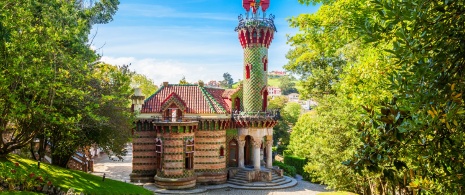
“El Capricho” of the sunflowers with sea views
The last stop on this peculiar Gaudí Way or the first, depending on the direction in which you wish to follow the route, will take you to Comillas, on the western coast of Cantabria. In addition to the appetising combination of beach, mountains and excellent gastronomy, this coastal town preserves a stately air that is reflected in its extensive modernist heritage. Gaudí's Capricho (1883-1885) was the first private house designed by the Spanish architect in his youth. The building stands out for its creativity, but also for the functionality of its spaces. It was built at the same time as the Casa Vicens of Barcelona, declared a World Heritage Site by UNESCO and with which it shares aesthetic and conceptual similarities. Sunflowers, music and nature are present in the decorative elements of this building, which is integrated into its surroundings in a sublime way. Today, 'El Capricho' is a monument that can be visited all year round, hosting children's workshops, classical music concerts and many other activities. Right beside it, you can find Sobrellano Palace, a blend of neo-Gothic and modernist styles and opposite, at the top of the hill, the Pontifical University, with Gothic-Mudéjar decoration, currently the headquarters of the International Centre for Higher Spanish Studies (CIESE-Fundación Comillas). Both buildings were designed by Joan Martorell, with the collaboration of other masters of the time, such as Luis Domènech i Montaner. The town's cemetery also has examples of impressive modernist sculpture, with “The Exterminating Angel” (1895), by Josep Llimona. The centre of town still has the charm of cobbled streets, with restaurants and traditional shops that coexist with small fashion boutiques, featuring modern fashion and accessories. The port area is ideal for savouring a portion of “rabas” (fried squid), an essential dish to experience the typical Cantabrian aperitif. The Gaudí Way allows visitors to enter the creative universe of one of the most influential architects in history and a passionate lover of nature and culture.
Travel plans for inspiring you
